Analysis for DC and RF Characteristics Recessed-Gate GaN MOSFET Using Stacked TiO2/Si3N4 Dual-Layer Insulator
Abstract
1. Introduction
2. Materials and Methods
3. Results
3.1. Dependence of Heat Generation on Oxide Capacitance
3.2. Temperature Sensitivity Comparison
3.3. Heat Transfer Materials
4. Conclusions
Author Contributions
Funding
Institutional Review Board Statement
Informed Consent Statement
Data Availability Statement
Conflicts of Interest
References
- Gupta, C.; Ji, D.; Chan, S.H.; Agarwal, A.; Leach, W.; Keller, S.; Chowdhury, S.; Mishra, U.K. Impact of trench dimensions on the device performance of GaN vertical trench MOSFETs. IEEE Electron Device Lett. 2017, 38, 1559–1562. [Google Scholar] [CrossRef]
- Ji, D.; Li, W.; Chowdhury, S. A study on the impact of channel mobility on switching performance of vertical GaN MOSFETs. IEEE Trans. Electron Devices 2018, 65, 4271–4275. [Google Scholar] [CrossRef]
- Tsai, C.Y.; Wu, T.L.; Chin, A. High-Performance GaN MOSFET with High-k LaAlO3/SiO2 Gate Dielectric. IEEE Electron Device Lett. 2012, 33, 35–37. [Google Scholar] [CrossRef]
- Subramani, N.K.; Couvidat, J.; Al Hajjar, A.; Nallatamby, J.C.; Sommet, R.; Quéré, R. Identification of GaN buffer traps in microwave power AlGaN/GaN HEMTs through low frequency S-parameters measurements and TCAD-based physical device simulations. IEEE J. Electron Devices Soc. 2017, 5, 175–181. [Google Scholar] [CrossRef]
- Lee, C.T.; Chiou, Y.L.; Lee, C.S. AlGaN/GaN MOS-HEMTs with gate ZnO dielectric layer. IEEE Electron Device Lett. 2010, 31, 1220–1223. [Google Scholar] [CrossRef]
- Hirama, K.; Kasu, M.; Taniyasu, Y. RF high-power operation of AlGaN/GaN HEMTs epitaxially grown on diamond. IEEE Electron Device Lett. 2012, 33, 513–515. [Google Scholar] [CrossRef]
- Huang, H.; Liang, Y.C.; Samudra, G.S.; Ngo, C.L.L. Au-free normally-off AlGaN/GaN-on-Si MIS-HEMTs using combined partially recessed and fluorinated trap-charge gate structures. IEEE Electron Device Lett. 2014, 35, 569–571. [Google Scholar] [CrossRef]
- Tang, Z.; Jiang, Q.; Lu, Y.; Huang, S.; Yang, S.; Tang, X.; Chen, K.J. 600-V Normally Off SiNx/AlGaN/GaN MIS-HEMT With Large Gate Swing and Low Current Collapse. IEEE Electron Device Lett. 2013, 34, 1373–1375. [Google Scholar] [CrossRef]
- Oka, T.; Nozawa, T. AlGaN/GaN recessed MIS-gate HFET with high-threshold-voltage normally-off operation for power electronics applications. IEEE Electron Device Lett. 2018, 29, 668–670. [Google Scholar] [CrossRef]
- Yuan, L.; Chen, H.; Chen, K.J. Normally off AlGaN/GaN metal–2DEG tunnel-junction field-effect transistors. IEEE Electron Device Lett. 2011, 32, 303–305. [Google Scholar] [CrossRef]
- Bi, Z.; Hao, Y.; Liu, H.; Liu, L.; Feng, Q. Characteristics analysis of gate dielectrics in AlGaN/GaN MIS-HEMT. In Proceedings of the IEEE International Conference of Electron Devices and Solid-State Circuits (EDSSC), Xi’an, China, 25–27 December 2009. [Google Scholar]
- Huang, Z.; Liu, J.; Huang, X.; Yao, J.; Zhang, J.; Guo, Y. Analysis of Interface Properties in AlGaN/GaN MIS-HEMTs with HfO2 and SiNx Gate Dielectric. In Proceedings of the 10th International Conference on Power and Energy Systems (ICPES), Chengdu, China, 25–27 December 2020. [Google Scholar]
- Jang, K.W.; Hwang, I.T.; Kim, H.J.; Lee, S.H.; Lim, J.W.; Kim, H.S. Thermal analysis and operational characteristics of an AlGaN/GaN High electron mobility transistor with copper-filled structures: A simulation study. Micromachines 2020, 11, 53. [Google Scholar] [CrossRef]
- Sahoo, A.K.; Subramani, N.K.; Nallatamby, J.C.; Sommet, R.; Quéré, R.; Rolland, N.; Medjdoub, F. Thermal analysis of AlN/GaN/AlGaN HEMTs grown on Si and SiC substrate through TCAD simulations and measurements. In Proceedings of the 11th European Microwave Integrated Circuits Conference (EuMIC), London, UK, 3–4 October 2016. [Google Scholar]
- Aouf, A.; Djeffal, F.; Douak, F. Thermal stability investigation of power GaN HEMT including self-heating effects. In Proceedings of the 6th International Conference on Systems and Control (ICSC), Batna, Algeria, 7–9 May 2017. [Google Scholar]
- Jung, J.H.; Cho, M.S.; Jang, W.D.; Lee, S.H.; Jang, J.W.; Bae, J.H.; Kang, I.M. Recessed-Gate GaN Metal-Insulator-Semiconductor High-Electron-Mobility Transistor Using a Dual Gate-Insulator Employing TiO2/SiN. J. Nanosci. Nanotechnol. 2020, 20, 4678–4683. [Google Scholar] [CrossRef]
- Ranjan, K.; Arulkumaran, S.; Ng, G.I.; Sandupatla, A. Investigation of Self-Heating Effect on DC and RF Performances in AlGaN/GaN HEMTs on CVD-Diamond. IEEE J. Quantum Electron 2019, 7, 1264–1269. [Google Scholar] [CrossRef]
- Podder, A.K.; Islam, A.J.; Hasanuzzaman, S.M.; Islam, M.S.; Bhuiyan, A.G. Substrate effects on channel temperature distribution of AlGaN/GaN HEMT. In Proceedings of the 3rd International Conference on Electrical Information and Communication Technology (EICT), Khulna, Bangladesh, 7–9 December 2017. [Google Scholar]
- Sarua, A.; Ji, H.; Hilton, K.P.; Wallis, D.J.; Uren, M.J.; Martin, T.A.M.T.; Kuball, M. Thermal boundary resistance between GaN and substrate in AlGaN/GaN electronic devices. IEEE Trans. Electron Devices 2007, 54, 3152–3158. [Google Scholar] [CrossRef]
- Belkacemi, K.; Hocine, R. Efficient 3D-TLM modeling and simulation for the thermal management of microwave AlGaN/GaN HEMT used in high power amplifiers SSPA. Int. J. Eng. Res. Appl. 2018, 8, 23. [Google Scholar] [CrossRef]
- Tawfik, M.M. Experimental studies of nanofluid thermal conductivity enhancement and applications: A review. Renew. Sustain. Energy Rev. 2017, 75, 1239–1253. [Google Scholar] [CrossRef]
- Rutkowski, P.; Stobierski, L.; Górny, G. Thermal stability and conductivity of hot-pressed Si 3 N 4–graphene composites. J. Therm. Anal. Calorim. 2014, 116, 321–328. [Google Scholar] [CrossRef][Green Version]
- Silvaco. Atlas User’s Manual Device Simulation Software; Silvaco: Santa Clara, CA, USA, 2010. [Google Scholar]
- Arivazhagan, L.; Jarndal, A.; Nirmal, D. GaN HEMT on Si substrate with diamond heat spreader for high power applications. J. Comput. Electron 2021, 20, 873–882. [Google Scholar] [CrossRef]
- Orouji, A.A.; Rahimian, M. Dual material insulator SOI-LDMOSFET: A novel device for self-heating effect improvement. Physica E Low Dimens. Syst. Nanostruct. 2011, 44, 333–338. [Google Scholar] [CrossRef]
- Basumatary, B.; Maity, S.; Muchahary, D. Improvement of drain current of AlGaN/GaN-HEMT through the modification of negative differential conductance (NDC), current collapse, self-heating and optimization of double hetero structure. Superlattices Microstruct. 2016, 97, 606–616. [Google Scholar] [CrossRef]
- Vitanov, S.; Palankovski, V.; Maroldt, S.; Quay, R. High-temperature modeling of AlGaN/GaN HEMTs. Solid State Electron. 2010, 54, 1105–1112. [Google Scholar] [CrossRef]
- Hansen, P.J.; Vaithyanathan, V.; Wu, Y.; Mates, T.; Heikman, S.; Mishra, U.K.; York, R.A.; Schlom, J.S.; Speck, J.S. Rutile films grown by molecular beam epitaxy on GaN and AlGaN/GaN. J. Vac. Sci. Technol. B 2005, 23, 499–506. [Google Scholar] [CrossRef]
- Yagi, S.; Shimizu, M.; Inada, M.; Yamamoto, Y.; Piao, G.; Okumura, H.; Yano, Y.; Akutsu, N.; Ohashi, H. High breakdown voltage AlGaN/GaN MIS–HEMT with SiN and TiO2 gate insulator. Solid State Electron. 2006, 50, 1057–1061. [Google Scholar] [CrossRef]
- Yang, S.; Tang, Z.; Hua, M.; Zhang, Z.; Wei, J.; Lu, Y.; Chen, K.J. Investigation of SiNx and AlN Passivation for AlGaN/GaN High-Electron-Mobility Transistors: Role of Interface Traps and Polarization Charges. IEEE J. Electron Devices Soc. 2020, 8, 358–364. [Google Scholar] [CrossRef]
- Chen, X.; Boumaiza, S.; Wei, L. Self-heating and equivalent channel temperature in short gate length GaN HEMTs. IEEE Trans. Electron Devices 2019, 66, 3748–3755. [Google Scholar] [CrossRef]
- Islam, S.; Li, Z.; Dorgan, V.E.; Bae, M.H.; Pop, E. Role of Joule heating on current saturation and transient behavior of graphene transistors. IEEE Electron Device Lett. 2013, 34, 166–168. [Google Scholar] [CrossRef]
- Huang, S.; Liu, X.; Wei, K.; Liu, G.; Wang, X.; Sun, B.; Yang, X.; Shen, B.; Liu, C.; Hua, M.; et al. O3-sourced atomic layer deposition of high quality Al2O3 gate dielectric for normally-off GaN metal-insulator-semiconductor high-electron-mobility transistors. Appl. Phys. Lett. 2015, 106, 033507. [Google Scholar] [CrossRef]
- Caddemi, A.; Crupi, G.; Donato, N. Microwave characterization and modeling of packaged HEMTs by a direct extraction procedure down to 30 K. IEEE Trans. Instrum. Meas. 2006, 55, 465–470. [Google Scholar] [CrossRef]
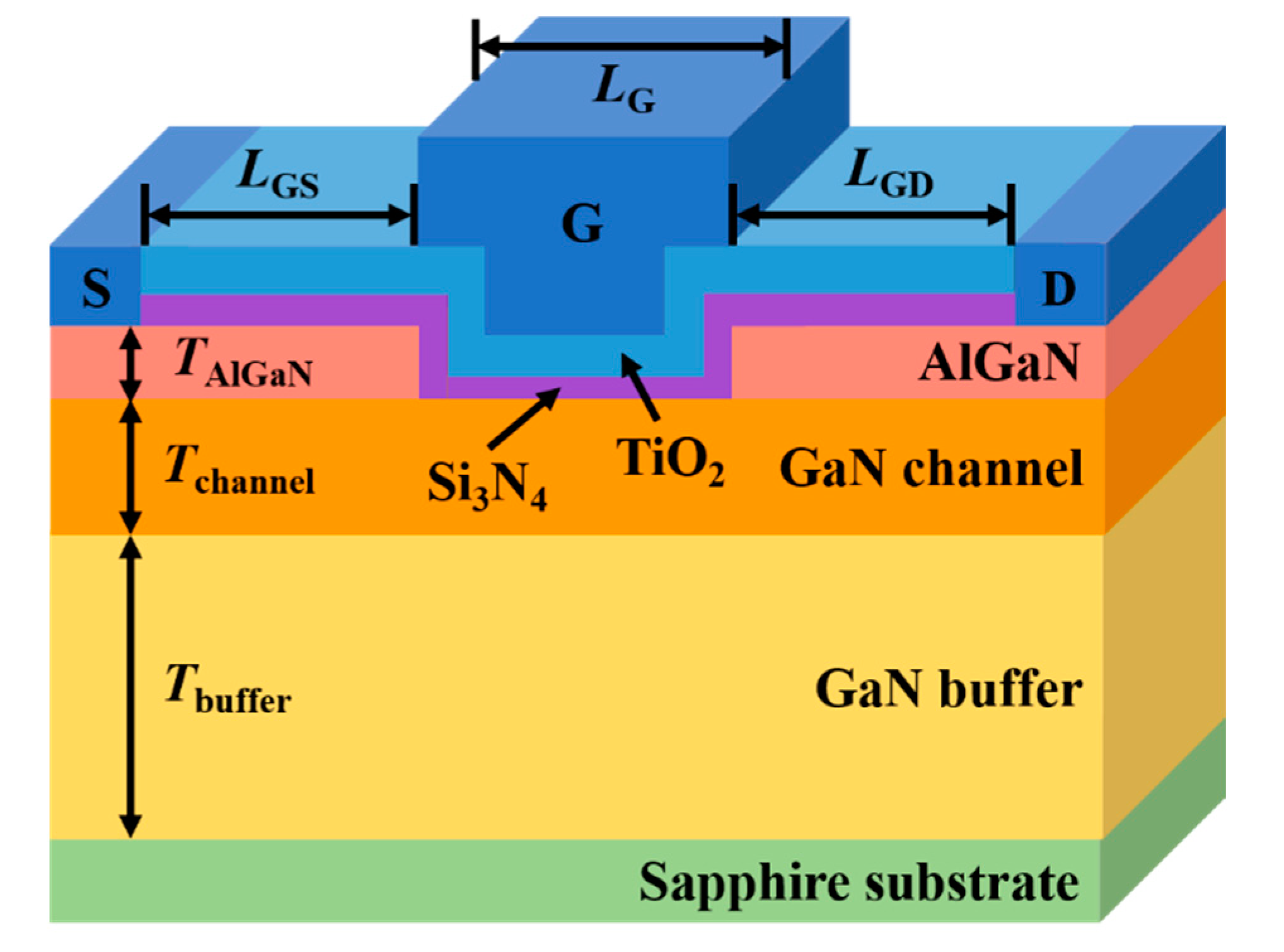



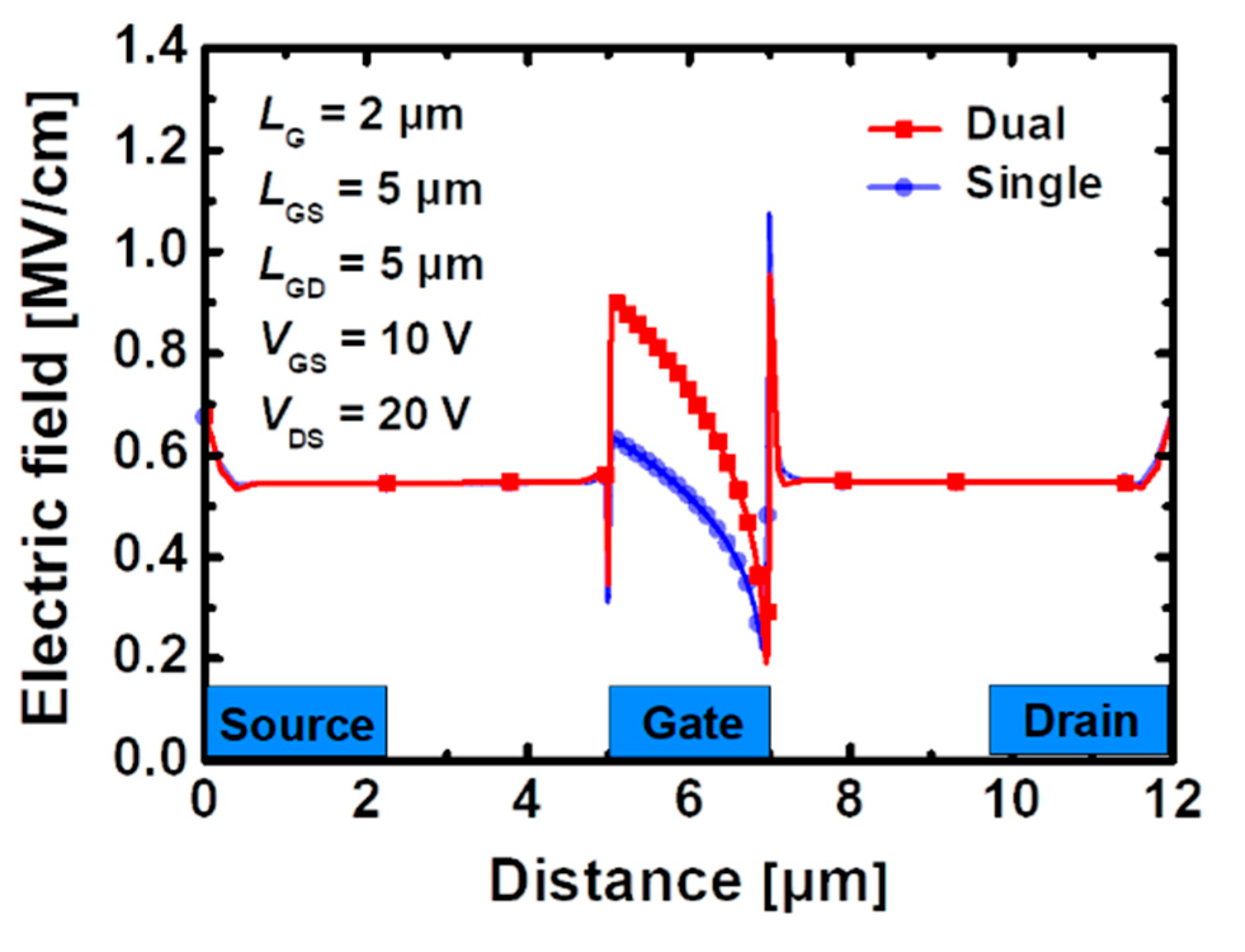
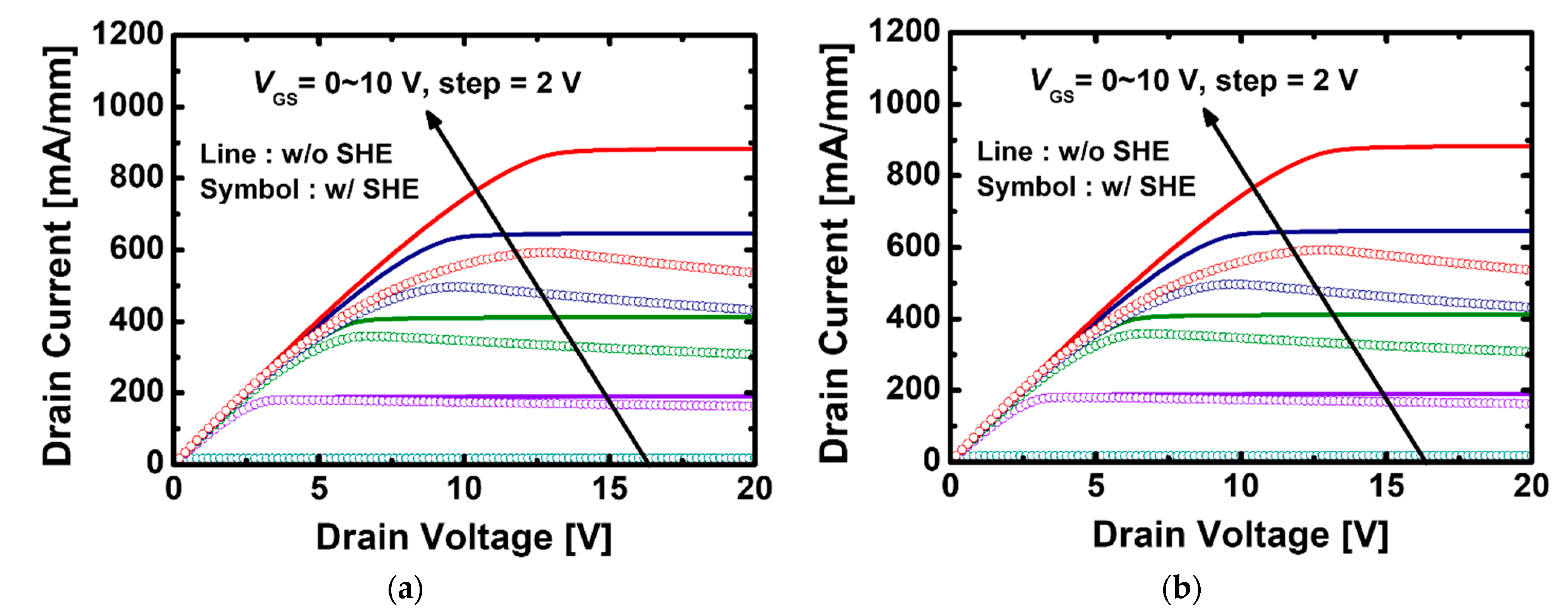
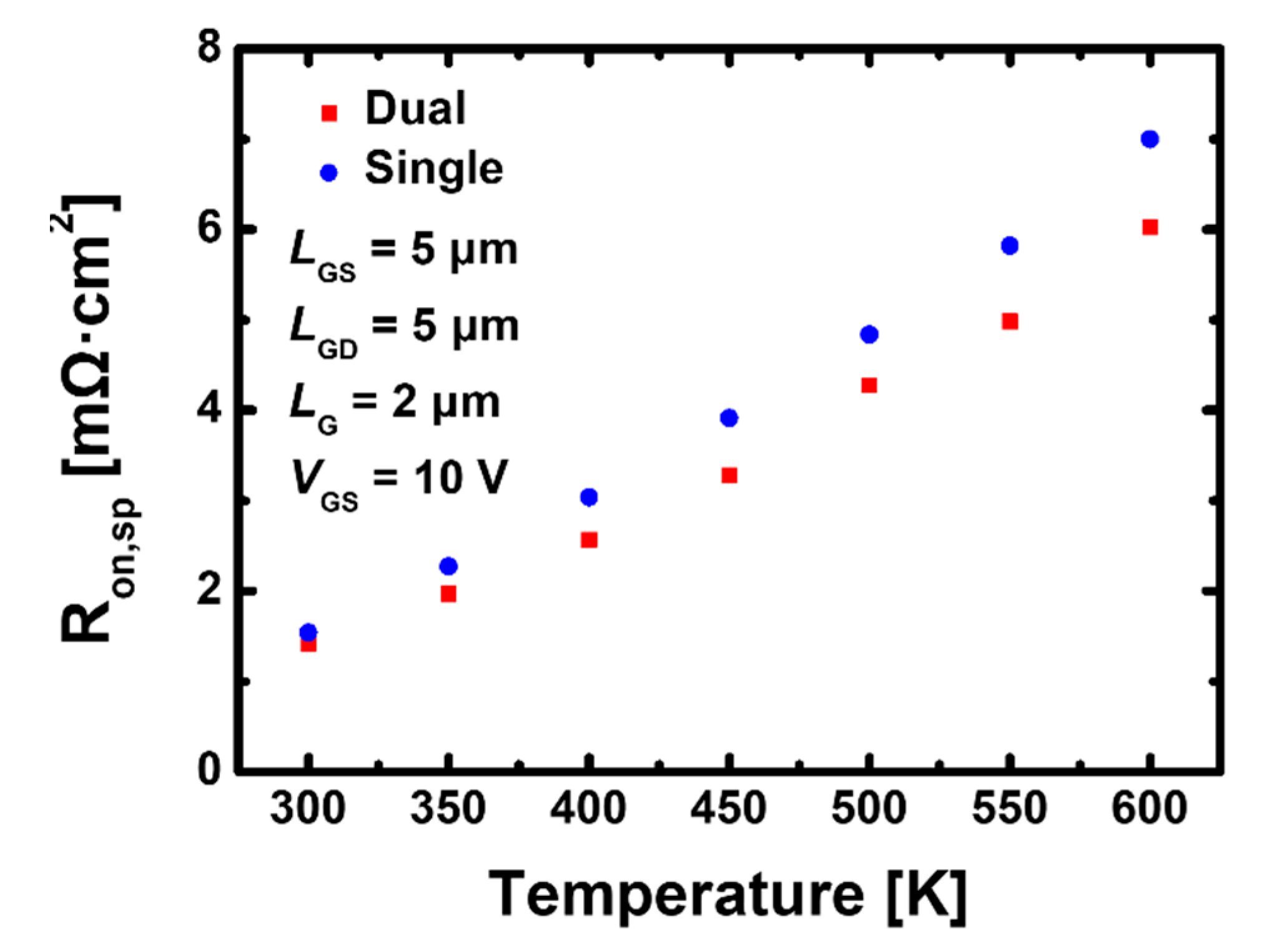

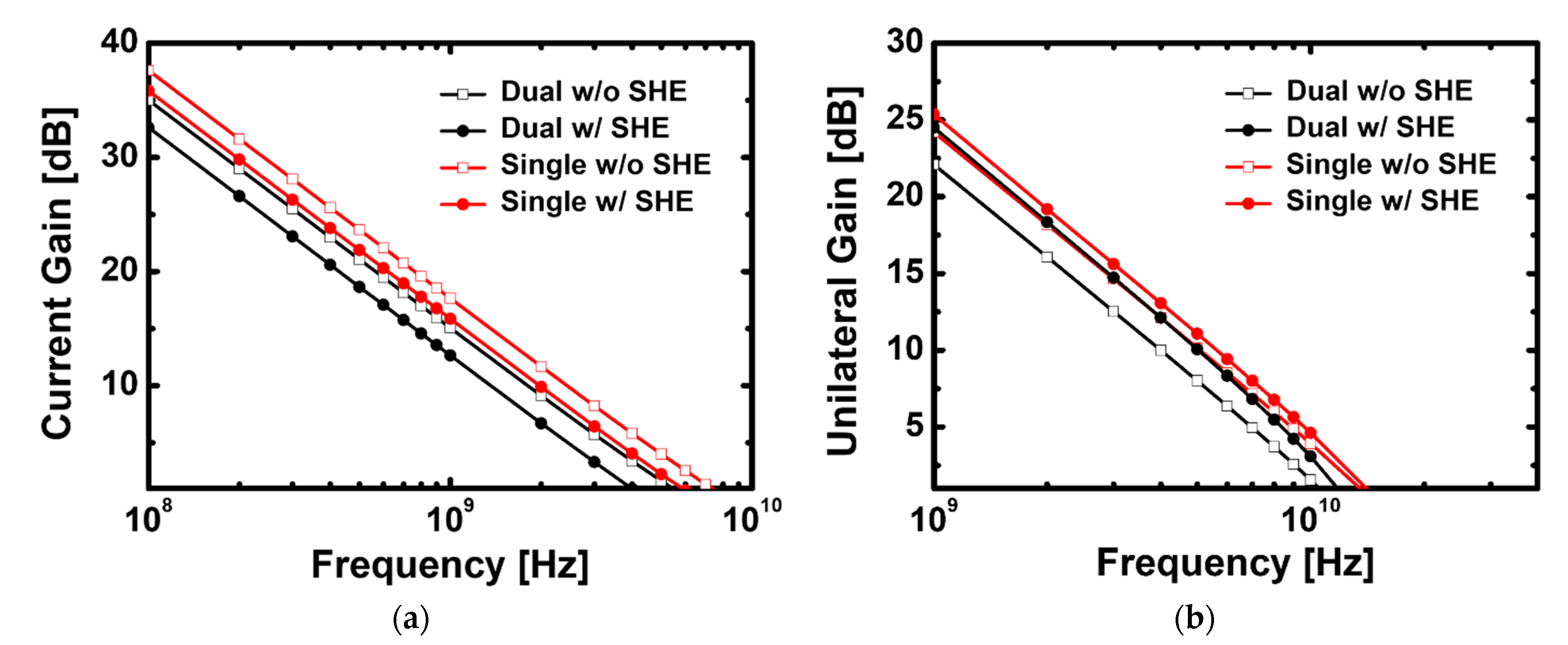
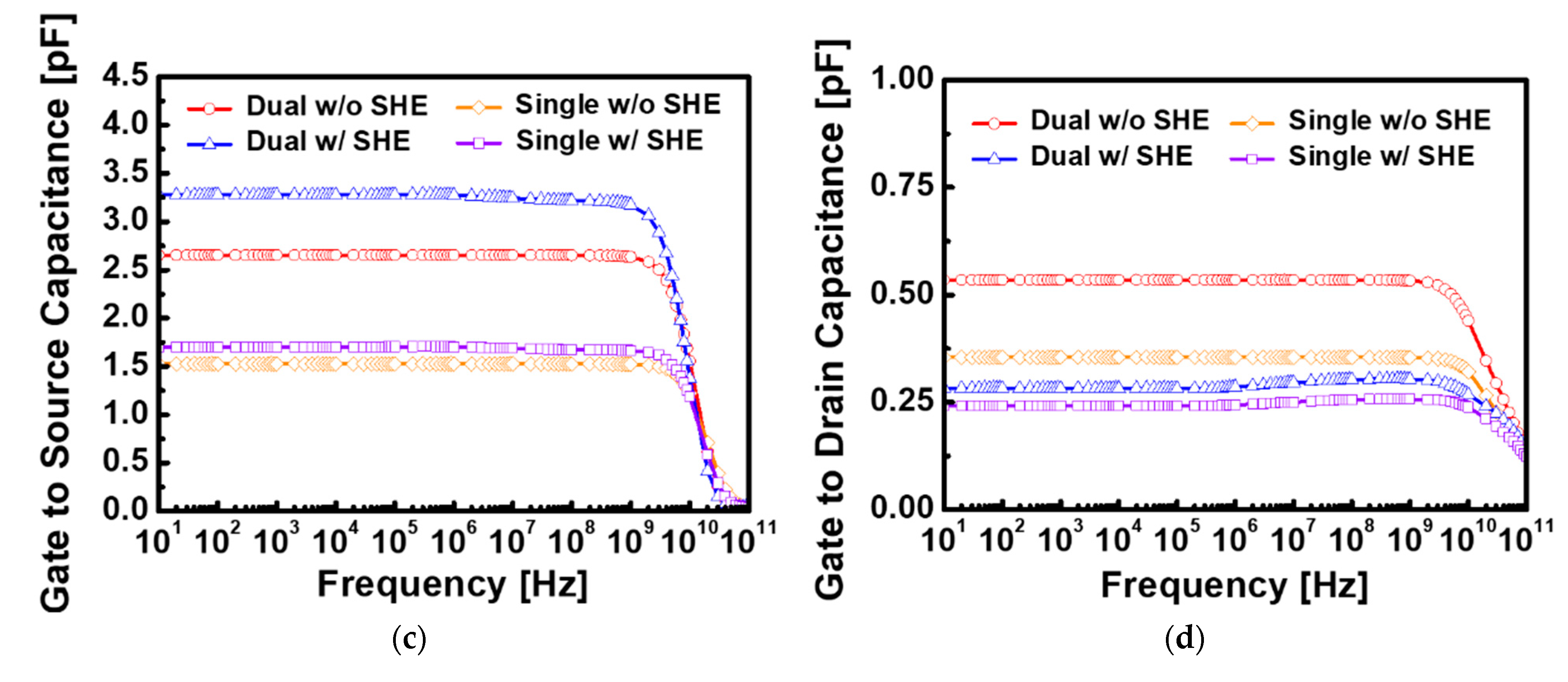

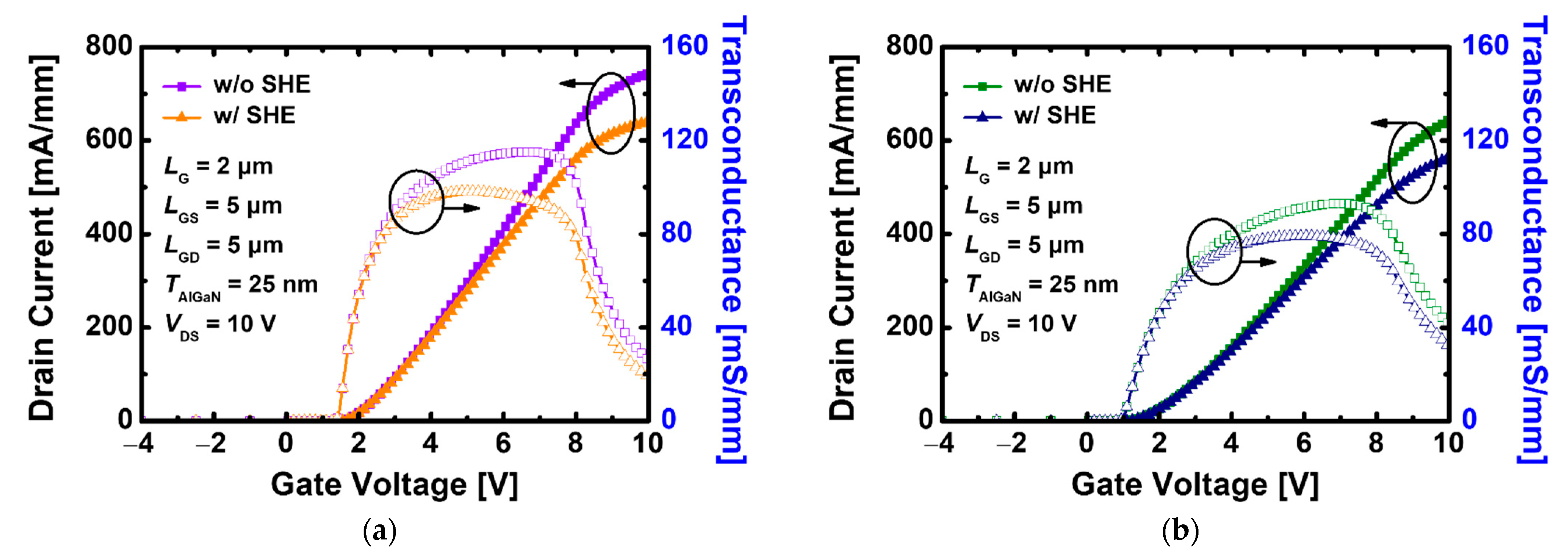

| Material | Thermal Conductivity (W/mK) |
|---|---|
| Si3N4 | 30 |
| TiO2 | 8.4 |
| GaN | 150 |
| AlGaN | 30 |
| SiC | 420 |
| Sapphire | 35 |
| Material | fT [GHz] | Cgs [pF] | Cgd [pF] | Cox [pF] |
|---|---|---|---|---|
| Dual w/o SHE | 5.45 | 2.57 | 0.53 | 3.10 |
| Dual w/SHE | 3.98 | 3.04 | 0.30 | 3.34 |
| Single w/o SHE | 7.36 | 1.51 | 0.35 | 1.86 |
| Single w/SHE | 5.86 | 1.65 | 0.26 | 1.91 |
Publisher’s Note: MDPI stays neutral with regard to jurisdictional claims in published maps and institutional affiliations. |
© 2022 by the authors. Licensee MDPI, Basel, Switzerland. This article is an open access article distributed under the terms and conditions of the Creative Commons Attribution (CC BY) license (https://creativecommons.org/licenses/by/4.0/).
Share and Cite
Min, S.-R.; Cho, M.-S.; Lee, S.-H.; Park, J.; An, H.-D.; Kim, G.-U.; Yoon, Y.-J.; Seo, J.-H.; Jang, J.-W.; Bae, J.-H.; et al. Analysis for DC and RF Characteristics Recessed-Gate GaN MOSFET Using Stacked TiO2/Si3N4 Dual-Layer Insulator. Materials 2022, 15, 819. https://doi.org/10.3390/ma15030819
Min S-R, Cho M-S, Lee S-H, Park J, An H-D, Kim G-U, Yoon Y-J, Seo J-H, Jang J-W, Bae J-H, et al. Analysis for DC and RF Characteristics Recessed-Gate GaN MOSFET Using Stacked TiO2/Si3N4 Dual-Layer Insulator. Materials. 2022; 15(3):819. https://doi.org/10.3390/ma15030819
Chicago/Turabian StyleMin, So-Ra, Min-Su Cho, Sang-Ho Lee, Jin Park, Hee-Dae An, Geon-Uk Kim, Young-Jun Yoon, Jae-Hwa Seo, Jae-Won Jang, Jin-Hyuk Bae, and et al. 2022. "Analysis for DC and RF Characteristics Recessed-Gate GaN MOSFET Using Stacked TiO2/Si3N4 Dual-Layer Insulator" Materials 15, no. 3: 819. https://doi.org/10.3390/ma15030819
APA StyleMin, S.-R., Cho, M.-S., Lee, S.-H., Park, J., An, H.-D., Kim, G.-U., Yoon, Y.-J., Seo, J.-H., Jang, J.-W., Bae, J.-H., Lee, S.-H., & Kang, I.-M. (2022). Analysis for DC and RF Characteristics Recessed-Gate GaN MOSFET Using Stacked TiO2/Si3N4 Dual-Layer Insulator. Materials, 15(3), 819. https://doi.org/10.3390/ma15030819







